Why is the color blue in a garden so exciting? We don’t see blue in nature as often as other colors, so blue flowers seem extra special. The color blue is also very soothing. If you crave ideas for blue annual flowers to plant at your home, read on for our inspired list of 10 blue beauties! These 10 blue annual flowers are a mix of tender and hearty plants that you might love so much you’ll plant them again next year.
If you see perennials on our list, it’s because they are also grown as annuals in colder growing zones. Some perennials do well in lower temperatures for one season, but likely won’t survive for the long term.
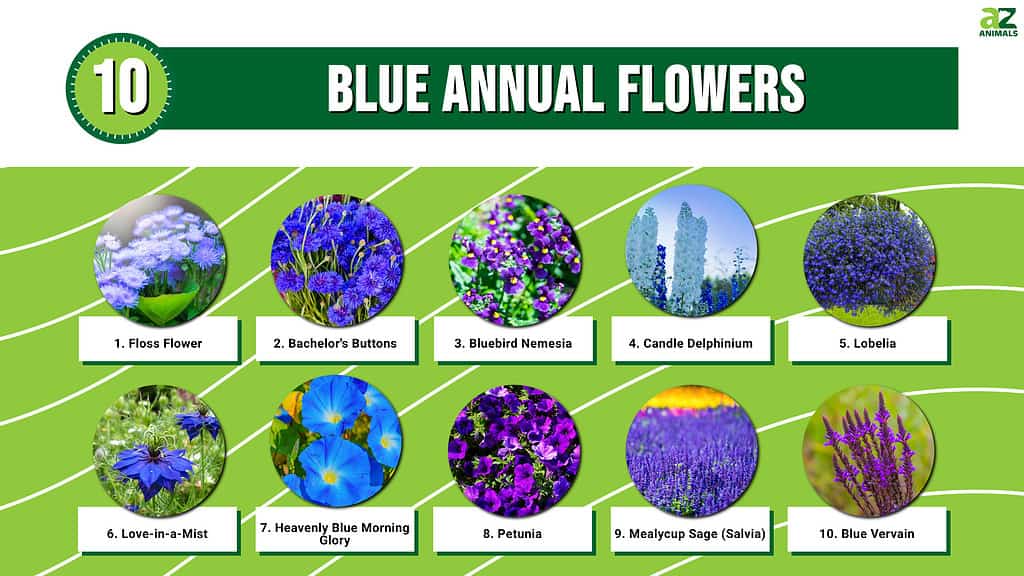
1. Floss Flower
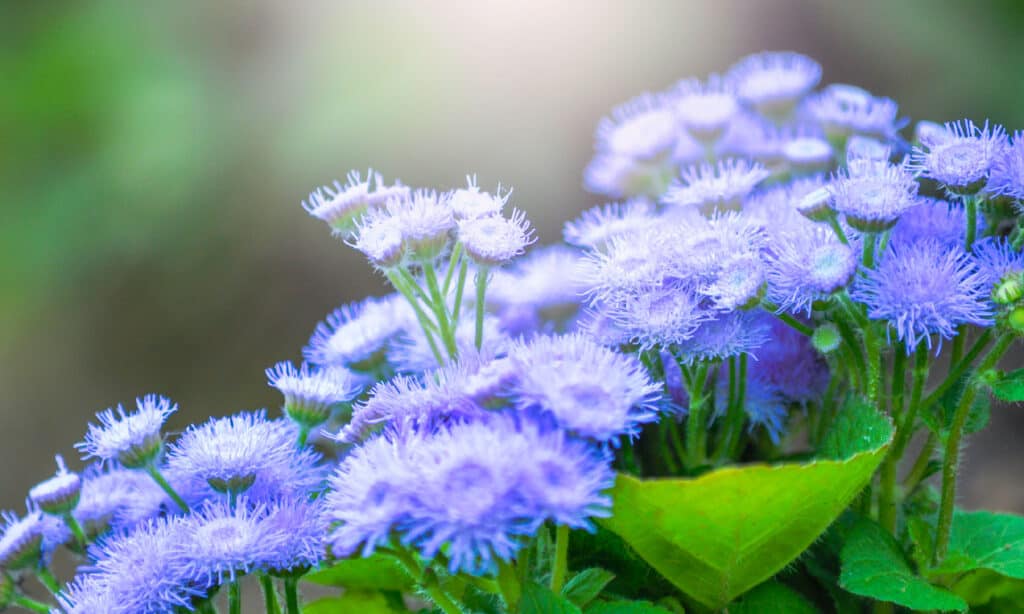
Floss flowers are good as ground covers.
©undefined undefined/Shutterstock.com
Botanical name: Ageratum houstonianum
Common names: Bluemink, blueweed
USDA hardiness zones: 10 to 11
Sun exposure: Full sun to partial shade
Mature size: Up to 36 inches tall and 18 inches wide
Bloom time: Summer to fall
Flower colors: Blue, lavender, pink, white
This showy annual with “flossy” blooms is a go-to for anyone who loves blue or lavender in the garden. Ageratum flowers, also called floss flowers, have that perfect powdery blue color that looks wonderful planted en masse in beds and borders. This blue flower is also lovely as ground cover.
Ageratum flowers are heat-tolerant and low-maintenance, making them ideal for busy gardeners. Ageratum houstonianum is the most common species grown but look for newer varieties with longer bloom times and improved disease resistance.
Floss flowers do best when planted in full sun. They tolerate light shade, but plants may become leggy and produce fewer flowers. Soil should be well-draining, as ageratums are susceptible to root rot if left in soggy conditions. However, these annuals are not particular about soil type and will do well in poor, sandy soils.
This blue herb with broad leaves will attract bees and butterflies to your garden. Ageratum pairs well with daisies, dahlias, and zinnias in flower arrangements.
2. Bachelor’s Buttons

Cornflowers are very easy to grow.
©EQRoy/Shutterstock.com
Botanical name: Centaurea cyanus
Common names: Cornflower
USDA hardiness zones: 2 to 11
Sun exposure: Full sun to partial shade
Mature size: Up to 48 inches tall and 10 inches wide
Bloom time: Summer
Flower colors: Blue/lavender, pink, white
Bachelor’s buttons are old-fashioned blue or lavender annual flowers grown in gardens for centuries. Cornflowers are easy to grow, do well in poor soil, and self-sow in the garden if you let them. These frilly round flowers prefer full sun but will tolerate some light shade. Soil should be well-draining. Deadhead spent blooms regularly for best performance.
The best placement in your garden for bachelor’s buttons might be in the middle or back of the border if you choose the taller varieties that grow up to 48 inches. Bachelor’s buttons look especially lovely when planted in a mass.
Bachelor’s buttons are also excellent cut flowers and make beautiful dried flowers. These blue cornflowers are also edible! The blooms and petals make pretty garnishes for salads and cocktails.
3. Bluebird Nemesia

Bluebird nemesia can grow up to 12 inches tall!
©iStock.com/Michael Kulmar
Botanical name: Nemesia fruticans
Common names: Bluebird, bush nemesia
USDA hardiness zones: 8 to 10
Sun exposure: Full sun to partial shade
Mature size: Up to 10-12 inches tall and 18 inches wide
Bloom time: Spring and fall
Flower colors: Blue, lavender, purple, orange, white, pink, red, bi-color
This tender blue-purple annual is an excellent choice for adding color to spring and fall gardens. However, the bluebird nemesia tends to do better in containers (rather than garden beds) with consistent watering and good drainage. Plant your bluebird flowers in full sun for best results, though they will tolerate some light shade.
Nemesia makes wonderful filler flowers and tends to grow en masse in the shape of a mound. They also have a pleasing clove fragrance, are heat-tolerant, and make excellent cut flowers.
4. Candle Delphinium

Candle delphinium is toxic and should not be handled with bare hands.
©LesiChkalll27/Shutterstock.com
Botanical name: Delphinium elatum
Common names: Candle delphinium, candle larkspur, larkspur
USDA hardiness zones: 3 to 7
Sun exposure: Full sun to partial shade
Mature size: Up to 46 inches tall and 24 inches wide
Bloom time: Summer
Flower colors: Blue, pink, white, lavender
Candle delphiniums or larkspurs are tall blue or lavender annual flowers that make a significant impact in the garden. They grow as long stalks bursting with cup-shaped blooms that look beautiful in cottage and cutting gardens.
Delphiniums need full sun to partial shade and well-draining deep soil. These blue annual flowers attract caterpillars, slugs, and snails, so practicing pest control might be necessary. However, the good news is that candle delphiniums are deer resistant and attract hummingbirds!
Consider planting your delphiniums in the back of the border to add height and a showy backdrop for shorter flowers in front.
This towering flower is known for its toxicity, so be mindful of pets and children playing near where delphiniums grow. Wear gloves when handling the plants, as touching their leaves can cause skin irritation. Do not ingest any part of delphiniums or their leaf residue.
5. Lobelia
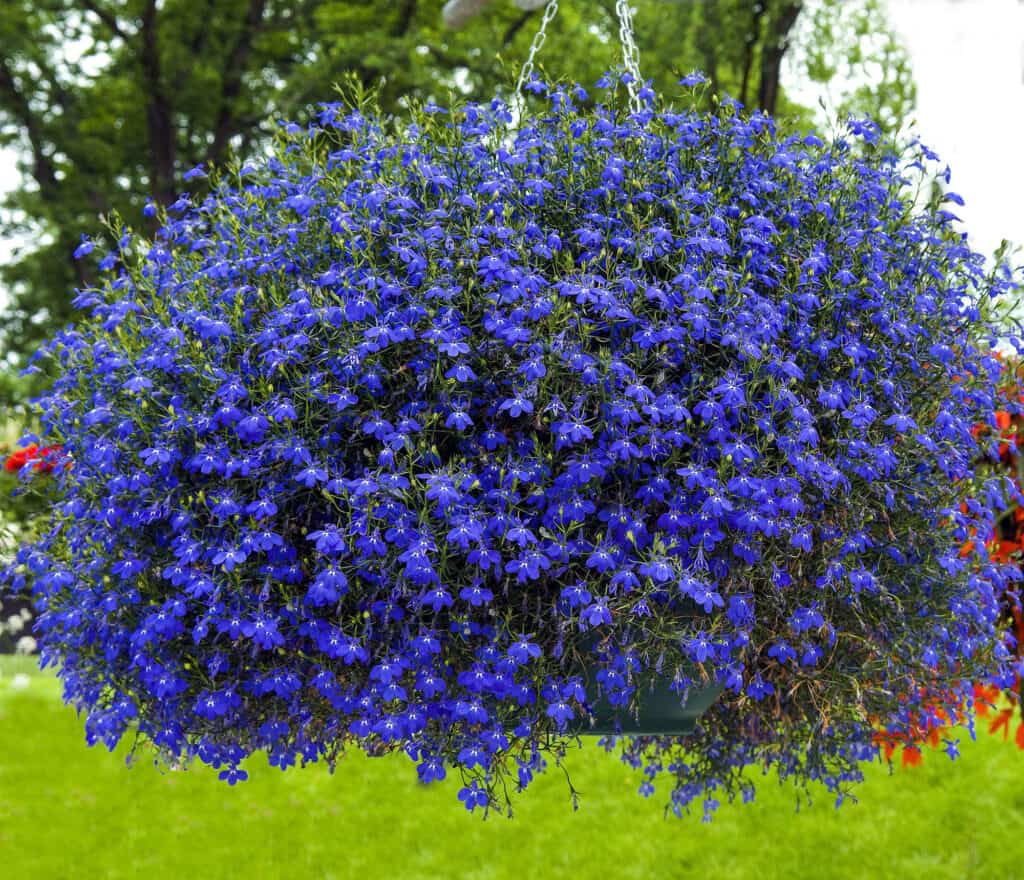
Lobelia is very good at attracting pollinators.
©iStock.com/emer1940
Botanical name: Lobelia erinus
Common names: Trailing lobelia, edging lobelia, annual lobelia
USDA hardiness zones: Most zones as an annual
Sun exposure: Full sun to partial shade
Mature size: Up to 12 inches high and 24 inches wide (for annuals)
Bloom time: Spring to fall, with a pause in midsummer
Flower colors: Blue, lavender, white, mauve, bi-color, pink
Lobelia is a fabulous choice if you’re looking for a “true blue” annual flower. It is a compact annual flower that is perfect for filling in gaps in the landscape. It has trailing stems with small flowers perfect for ground cover, containers, and garden borders. And if you want to attract pollinators, the trailing lobelia won’t disappoint!
Annual lobelia plants prefer full sun to light shade for most of the growing season. However, your lobelias might struggle in the mid-summer heat, so give them some extra shade time during the hottest days of the year.
Soil should be well-draining and kept moist. Water lobelias regularly, as lobelias will wilt in dry conditions. When planning the placement of annual lobelia, keep in mind that it will spill over the edge of containers and hanging baskets. It also looks nice when planted along a pathway.
6. Love-in-a-Mist
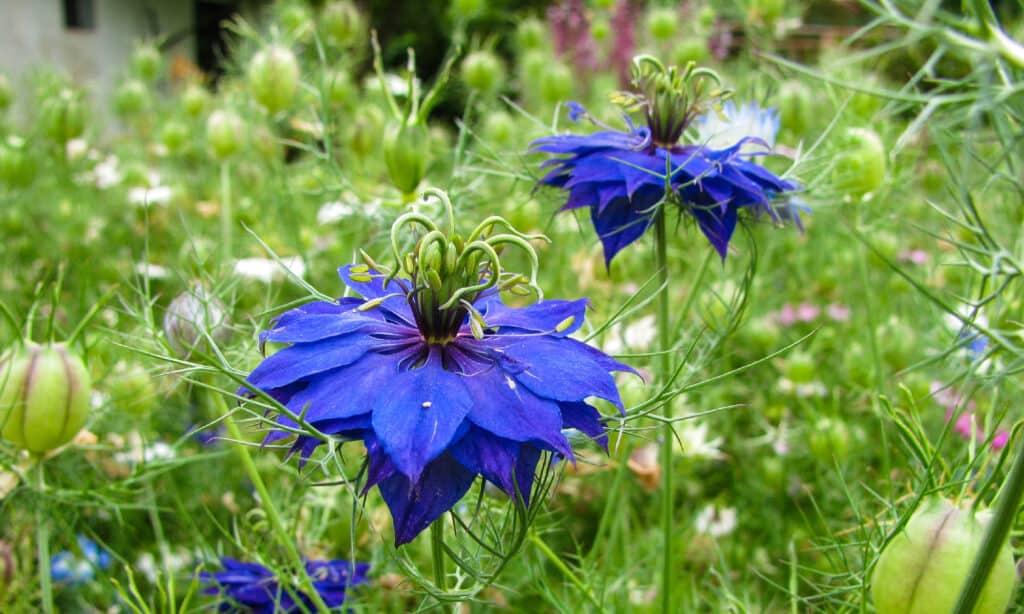
Love-in-a-mist is a good choice for a cottage garden.
©Heike Rau/Shutterstock.com
Botanical name: Nigella damascena
Common names: Love-in-a-mist, devil in a bush, ragged lady, hair of venus
USDA hardiness zones: 2 to 11
Sun exposure: Full sun preferred
Mature size: Up to 2 feet tall, 12 inches wide
Bloom time: Spring and fall
Flower colors: Blue, lavender, purple, mauve, white, pink
Love-in-a-mist is an annual flower that is easy to grow from seed. It has delicate, fern-like foliage and pretty blue flowers that bloom in spring and then again in autumn. The flowers are surrounded by spiky seedpods that add interest to bouquets and dried arrangements. Love-in-a-mist is a good choice for cottage gardens and meadow gardens.
Love-in-a-mist prefers full sun but might tolerate some partial shade. However, this delicate flower does not love high heat. So don’t expect blooms in mid-summer, but this flower should show off its pretty blue petals again in the fall.
Where should you plant these lovely blue annual flowers? You may want to place them along the edge of a garden bed or in front of the border. They also look nice when planted in masses.
7. Heavenly Blue Morning Glory

The morning glory flower is drought resistant.
©Hemerocallis/Shutterstock.com
Botanical name: Ipomoea tricolor ‘Heavenly Blue’
Common names: Morning glory, blue morning glory, grannyvine
USDA hardiness zones: 2 to 12
Sun exposure: Full sun preferred
Mature size: Up to 12 feet tall, 10 feet wide
Bloom time: Summer through early fall
Flower colors: Blue
‘Heavenly blue’ morning glory is a fast-growing vine perfect for covering fences, arbors, pergolas, and trellises. This climbing annual has large trumpet-shaped flowers that bloom in summer.
These blue flowers are easy to grow from seed, but they also easily self-seed and can be invasive in some regions. So be sure to plant your morning glories where they have room to spread. The best place in your garden for blue morning glory flowers is an area that gets full sun. These annuals will tolerate some light shade, but they won’t bloom as profusely in shady spots.
Morning glories prefer moist, well-drained, and loamy soil. They are drought-tolerant once established, but they will produce more flowers if you water them regularly.
As with delphiniums, heavenly blue morning glories should be handled with gloves due to their natural toxicity. Wash hands after touching these plants, and don’t let young children or pets play near the vines.
8. Petunia

The blue petunia is a popular annual flower.
©iStock.com/skymoon13
Botanical name: Petunia x atkinsiana
Common names: Petunia
USDA hardiness zones: Most zones as annuals
Sun exposure: Full sun preferred
Mature size: Up to 18 inches tall, 4 feet wide
Bloom time: Spring to fall
Flower colors: Blue, white, yellow, pink, purple, red, bi-color
Blue varieties of petunias are popular annual flowers. They’re easy to grow, do well in containers, and bloom from spring to fall. Petunias are also tolerant of heat and humidity, making them a good choice for gardens in hot climates. Grow petunias in full sun for best performance.
Petunias produce pretty funnel-shaped blooms that look great in pots on a sunny deck or planted along pathways and garden borders.
Your petunias need well-drained, moist soil. Water them once a week in the garden, and more often in containers and high heat.
Note that the botanical name for petunia we’ve listed here is for a common hybrid found through most plant and seed shops. There are many species of petunias to choose from, so shop around to find a wide selection!
Petunias come in multiple varieties of blue. Here’s a brief list of some of the standard blue petunias you might find at your local garden center:
- Bella Picotee Blue
- Capri Blue
- Carpet Blue
- Carpet Blue Lace
- Daddy Blue
- Mambo Blue
- Night Blue
- Storm Deep Blue.
9. Mealycup Sage (Salvia)
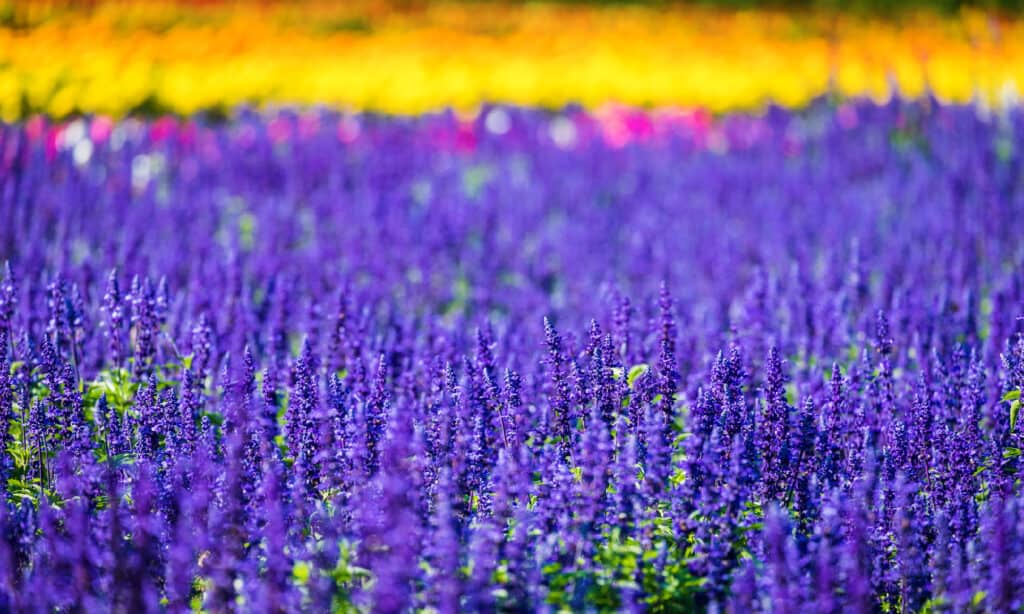
Mealycup sage is a low-maintenance garden flower.
©iStock.com/Biscut
Botanical name: Salvia farinacea
Common names: Mealycup sage, blue sage
USDA hardiness zones: 4 to 10 as annuals
Sun exposure: Full sun to partial shade
Mature size: Up to 2 feet tall
Bloom time: Spring to fall
Flower colors: Blue-violet
Mealycup sage is a blue-violet variety of salvia and a favorite flower of hummingbirds and butterflies. This blue garden flower is a tender perennial in warm climates and grows as an annual in colder zones. Mealycup sage has tiny blue flowers on thin spikes that bloom from spring to fall. This salvia prefers well-drained soil.
Blue salvia is a low-maintenance garden flower that can be left alone to bloom once in the spring. However, for a second and third bloom, you’ll want to prune Mealycup sage twice each growing season. Prune them after their flowers die off in spring and after the second bloom in mid-summer.
The ideal placement for Mealycup sage is along the edge of a bed or in front of the border. Though this flower’s spikes are tall and thin, its foliage gets bushy. Note that salvia’s branches can splay out as the blooming spikes up top get taller.
10. Blue Vervain

The blue vervain requires regular watering.
©Danny Hummel/Shutterstock.com
Botanical name: Verbena hastata
Common names: Swamp verbena, blue vervain, simpler’s joy
USDA hardiness zones: 3 to 9
Sun exposure: Full sun to partial shade
Mature size: Up to 5 feet tall, 3 feet wide
Bloom time: Late summer
Flower colors: Blue-violet
Blue vervain or verbena is a drought-tolerant annual that grows in clumps and often self-seeds. Like other spike plants, this flower is stalk-shaped with small florets. It grows wild in many fields of warmer hardiness zones and is a pollinator magnet that blooms mainly in late summer. Blue vervain makes for wonderful groundcover flowers in full sun to partial shade.
Sparrows and cardinals eat blue vervain seeds, and rabbits might eat the leaves.
Water your blue vervain flowers regularly to keep their soil moist. This verbena variety loves growing in floodplain soil, so plant it near water features for extra moisture. Verbena is also a good choice for rock, rain, and container gardens.
Summary of 10 Blue Annual Flowers
Here’s a recap of 10 beautiful blue annual flowers that we took a close look at:
| Number | Annual | USDA Hardiness Zone | Flower Colors |
|---|---|---|---|
| 1 | Floss Flower | 10 to 11 | Blue, lavender, pink, white |
| 2 | Bachelor’s Buttons | 2 to 11 | Blue/lavender, pink, white |
| 3 | Bluebird Nemesia | 8 to 10 | Blue, lavender, purple, orange, white, pink, red, bi-color |
| 4 | Candle Delphinium | 3 to 7 | Blue, pink, white, lavender |
| 5 | Lobelia | Most zones as annuals | Blue, lavender, white, mauve, bi-color, pink |
| 6 | Love-in-a-Mist | 2 to 11 | Blue, lavender, purple, mauve, white, pink |
| 7 | Heavenly Blue Morning Glory | 2 to 12 | Blue |
| 8 | Petunia | Most zones as annuals | Blue, white, yellow, pink, purple, red, bi-color |
| 9 | Mealycup Sage (Salvia) | 4 to 10 as annuals | Blue-violet |
| 10 | Blue Vervain | 3 to 9 | Blue-violet |
Grow Blue Annual Flowers in Your Garden!
Add blue flowers to your garden where you want cool colors with soothing energy. Whether the majestic morning glory or classic bachelor button, blue blooms encourage relaxation. So plant some blue annual flowers as a reminder to take a breath and enjoy nature!
The photo featured at the top of this post is © undefined undefined/Shutterstock.com
Sources
- Proven Winners (1970) provenwinners.com/search/content/blue petunia
- Gardenia (1970) gardenia.net/plant/ipomoea-tricolor-heavenly-blue-morning-glory
Thank you for reading! Have some feedback for us? Contact the AZ Animals editorial team.






